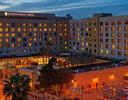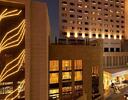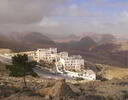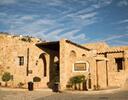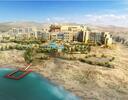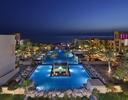Best of Jordan ... Best of Middle East !
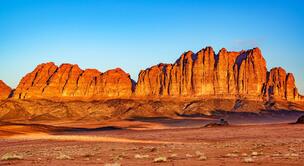
A safe haven in a region of conflict, Jordan has delighted visitors for centuries with its World Heritage Sites, friendly towns and inspiring desert landscapes.
Ancient Hospitality
Jordan has a tradition of welcoming visitors: camel caravans plied the legendary King’s Highway transporting frankincense in exchange for spices while Nabataean tradesmen, Roman legionnaires, Muslim armies and zealous Crusaders all passed through the land, leaving behind impressive monuments. These monuments, including Roman amphitheatres, Crusader castles and Christian mosaics, have fascinated subsequent travellers in search of antiquity and the origins of faith. The tradition of hospitality to visitors remains to this day.
Petra: A World Wonder
Petra, the ancient Nabataean city locked in the heart of Jordan’s sandstone escarpments, is the jewel in the crown of the country’s many antiquities. Ever since explorer Jean Louis Burckhardt brought news of the pink-hued necropolis back to Europe in the 19th century, the walk through the Siq to the Treasury (Petra’s defining monument) has impressed even the most travel weary of visitors. With sites flung over a vast rocky landscape and a mood that changes with the shifting light of dawn and dusk, this is a highlight that rewards a longer visit.
Desert Landscapes
Take a ride through Wadi Rum at sunset, and it's easy to see why TE Lawrence (Lawrence of Arabia) was so drawn to this land of weathered sandstone and reddened dunes. But Jordan's desert landscapes are not confined to the southeast: they encompass a salt sea at the lowest point on earth, canyons flowing with seasonal water, oases of palm trees and explosions of springtime flowers scattered across arid hills. Minimal planning and only a modest budget is required for an adventure.
Safe Haven
It takes tolerance to host endless waves of incomers, and Jordan has displayed that virtue amply, absorbing thousands of refugees from the Palestinian Territories, Iraq and most recently Syria. Despite contending with this and with large numbers of tourists who are often insensitive to conservative Jordanian values, rural life in particular has managed to keep continuity with the traditions of the past. While Jordan faces the challenges of modernisation and growing urbanisation, it remains one of the safest countries in which to gain an impression of the quintessential Middle East.
This itinerary covers most of the major cities of Jordan along with the main experiences, and popular sites that one should see. You’ll experience Jordan’s great history and traditional culture, and enjoy the hospitality of its people.
Highlights
- Experience the uniqueness of the major cities in Jordan
- Visit Wadi Rum and see it the way it is meant to be seen
- Have a meal in a local family home and experience the fullest belly in your life
- Visit crusader castles and experience history that changed the region forever
- See the rose red city of Petra and experience hidden treasures few tourists see
- Hop on board a boat in the sea port of Aqaba for a day of diving or snorkeling
- Float in the Dead Sea and have your very own Dead Sea mud experience
Itinerary
- Day 1
Arrival Amman / Day at leisure to explore the downtown
Arrive at the Amman Airport where, you will be met by our representative, transfer to your hotel for check in
Amman is one of the oldest cities in the world, inhabited since the bronze age. The city is growing into a modern city, but retains its character and history.
As Middle Eastern cities go, Amman is a relative youth, being mostly a creation of the 20th century. But though it lacks the storied history and thrilling architectural tapestry of other regional capitals, there�s plenty here to encourage you to linger awhile before making for Petra, the Dead Sea or Wadi Rum. In fact, Amman is one of the easiest cities in which to enjoy the Middle East experience.
Downtown Amman is a must-see. At the bottom of the city�s many hills and overlooked by the magisterial Citadel, it features spectacular Roman ruins, an international-standard museum and the hubbub of mosques, souqs and coffeehouses that are central to Jordanian life.
Elsewhere, urbane western Amman has leafy residential districts, cafes, bars, modern malls and art galleries; and in earthy eastern Amman, it�s easy to sense the more traditional and conservative pulse of the capital.
Day at leisure to rest or explore the surroundings on your own � We recommend you take a walk downtown �
From Jabal Al Weibdeh you are just a twenty minute downhill walk from downtown Amman. Full of markets and small shops, downtown Amman is essentially the heart of the city. Here you will find traders selling almost everything you might want, from fruit and vegetables to clothing, books and souvenirs.
The main fruit and vegetable market, also known as the central market, is located just behind the Grand Husseini Mosque, which itself is worth a visit.
Later, from downtown, head up to Jabal Amman where you can watch the sun set over the city before heading to Rainbow Street to enjoy the rest of the evening.
Originally named Abu Bakr Al Siddiq Street, Rainbow Street is one of the busiest in the city, and a favourite place for locals and tourists to gather in the evenings. It runs from 1st circle through to Mango Street, and is home to many attractions such as rooftops, restaurants and bars.
Overnight at Amman - Day 2
Amman / City Tour
After breakfast, full day sightseeing tour exploring Amman
Our experienced guide will start with teaching you a few Arabic greetings that will help you communicate with the Jordanians you will meet on your tour. Throughout the trips, we'll add a few more words in which help for you to engage with the people you meet. Many people speak English, but you'll get a warm reception as you use some Arabic.
We'll start with visiting the Citadel, where in the Old Testament King David arranged to have his lover�s husband murdered. The citadel overlooks the amphitheater and old downtown.
We then drive to Jebel Webdeh, the arts and cultural district passing art galleries and local antiquities and handcraft shops.
Next we drive to 1st Circle and start our walking tour on Rainbow street, lined with cafes, before descending colourful steps into the heart of the old city, passing Wild Jordan, a division of the Royal Society for the Conservation of Nature.
Stopping at local restaurants to sample falafel, hummus and the Arab delicacy, Kenafah, eaten at times of celebration.
Continue through the streets and markets, visiting the Husseini mosque and time permitting the amphitheater.
The evening will provide time to relax in the hotel or explore the various local restaurants to sample Jordanian food.
Overnight at Amman - Day 3
Amman / Excursion to Jerash & Ajloun
After breakfast, pick up from Amman and drive north to Jerash [50 kms.], one of the most preserved Greco-Roman cities in the Middle East.
Arriving in the modern town of Jerash, with its provincial streets and small market gardens, you see little to suggest its illustrious past. But the moment you cross from the new town into the ancient city, its boundary marked by the imposing Hadrian�s Arch, it becomes apparent that this was once no ordinary backwater but a city of great wealth and importance.
While the Middle East contains other surviving Roman cities that boast similar architectural treasures, the ancient ruins at Jerash are famous for their remarkable state of preservation. Enough structures remain intact for archaeologists and historians, and even casual visitors, to piece together ancient life under the rule of an emperor.
Visit the ruins and souk at Jerash
The ruined city of Jerash is Jordan's largest and most interesting Roman site, and a major tourist drawcard. Its imposing ceremonial gates, colonnaded avenues, temples and theatres all speak to the time when this was an important imperial centre. Even the most casual fan of archaeology will enjoy a half-day at the site � but take a hat and sunscreen in the warmer months, as the exposed ruins can be very hot to explore.
The site covers a huge area and can seem daunting at first, especially as there's virtually no signage. Walking at a leisurely pace, and allowing time for sitting on a fallen column and enjoying the spectacular views, you can visit the main ruins in a minimum of three to four hours.
Later proceed to Ajloun [20 kms.] and visit the castle, dominating the Ajloun skyline. It was built to ward off the Crusader armies at the key trade and pilgrimage intersection between Jerusalem, Cairo, Damascus and Mecca.
It may look a bit rough around the edges, but Ajloun is founded on an ancient market town and boasts a 600-year-old mosque with a fine stone-dressed minaret. Most visitors, however, don�t come to experience this chaotic little hub and its limited attractions: they come for the impressive castle perched atop a nearby hill, where it has commanded the high ground for nearly 1000 years.
We then head to the village of Orjan [10 kms] for an experience of more traditional life. Meeting our local host at the olive groves, to see the trees that have provided olives for hundreds of years. We then take a short walk to our host's family home, where you will be introduced to the culture and daily life of the host community, and sample a delicious feast of traditional food cooked by his family. A great opportunity to ask questions about life in rural Jordan.
Return to Amman for the evening ... 80 kms.
Overnight at Amman - Day 4
Amman to Petra / Enroute visit Mount Nebo, Madaba, Kera, Shobak
After breakfast, you start the journey to the south, beginning with Mount Nebo [35 kms.]
Mt Nebo is where Moses is said to have seen the Promised Land, a land he was himself forbidden to enter. It's believed that he died aged 120 and was later buried in the area, although the exact location of the burial site is the subject of conjecture.
Then on to the town of Madaba [10 kms.] and discover the amazing Byzantine mosaics excavated from throughout the town. See the Madaba Map, the oldest preserved mosaic map of the Holy Lands.
Continue south to the ancient crusader castle in Karak [115 kms.], exploring the maze of stone-vaulted halls and passageways. The city of Karak was the capital of Moab and the castle dominates the skyline. The castle provides an impressive insight into the architectural and military skills of the Crusaders.
Continue south and stop at Shobak castle, also known as Montreal, providing a contrasting example to Kerak.
We finish the day with driving to Petra [175 kms.]
Petra, the great Ancient City that lies half-hidden in the wind-blown landscape in southern Jordan, is one of the world's most treasured Unesco Heritage Sites. Voted by popular ballot in 2007 as one of the 'New Seven Wonders of the World', it has retained its magnetism even through times of strife in the wider region.
A visit to Petra when it was rediscovered for the wider world by Jean Louis Burckhardt in the 19th century meant going in disguise, speaking in local dialect and engaging the trust of surrounding tribespeople. Today visitors are welcomed both by the Bedouin who still relate to the Ancient City as home, and by the townspeople of neighbouring Wadi Musa whose facilities make a several-day visit to the Ancient City a pleasure. With nearby Nabataean attractions at so-called Little Petra, desert camping and numerous hiking opportunities, at least two days should be allowed to do Petra justice.
Check in at hotel on arrival for overnight stay - Day 5
Petra / Sightseeing
After breakfast, sightseeing of Petra
Start with visit to the Petra Visitor Centre. Now one of Modern Seven Wonders of the World, Petra is known by many names, a master piece half as old as time, the Red Rose city. Marvel at the beauty of the �Lost City�, only recently re-discovered by the outside world.
Walk through the Siq and be astounded as you reach the magnificent Treasury, the entrance guarding the ancient Nabatean city.
Then continue into the city, viewing the amphitheater, exploring its many caves and tombs.
After lunch there is time to explore off the beaten path where many tourists don't tread and visit some of the hidden treasures of Petra, such as the Monastery or amazing view overlooking the Treasury from Jebel Khubtha.
The final twist of the towering walls of the Siq canyon brings the iconic image of Petra: the stunning Treasury in sudden view. This well-trodden trail, which breezes past the Street of Facades and onward to the Monastery, makes for a great introduction to one of the Middle East's most-visited sights, but if you dig a little deeper, the din of those half a million annual visitors will start to fade, and the real Indiana Jones experience can begin.
Adventurous travellers often deviate from the main trail through Petra to climb to the High Place of Sacrifice, an area of temples with stunning views of the valley below. It's well worth the trip, but on the way down to reconnect with the main route, push a little further. The walk back past Wadi Farasa offers ample opportunity to sit down for tea with a local family or explore tomb complexes where little more than goat droppings mark the passage of time. Either experience adds a certain depth to Petra that most visitors never make time for.
Overnight at Petra - Day 6
Petra to Wadi Rum / Camel Ride & Jeep Tour
After breakfast, depart from Petra and head to Wadi Rum � 110 kms.
Wadi Rum is everything you�d expect of a quintessential desert: it is extreme in summer heat and winter cold; it is violent and moody as the sun slices through chiselled siqs (canyons) at dawn or melts the division between rock and sand at dusk; it is exacting on the Bedouin who live in it and vengeful on those who ignore its dangers. For most visitors, on half- or full-day trips from Aqaba or Petra, Wadi Rum offers one of the easiest and safest glimpses of the desert in the region. For the lucky few who can afford a day or two in their itinerary to sleep over at one of the desert camps, it can be an unforgettable way of stripping the soul back to basics.
On arrival at the camp, you will start your desert adventure with a camel ride out into the magical mountainous desert.
You will then meet you Bedouin hosts and start a jeep safari exploring this World Heritage Site, traveling around Wadi Rum�s valleys, canyons, dunes and deserts, discover rock inscriptions, majestic views of mountains and landscapes and narrow gorges.
At each stop you have the opportunity to hike and scramble and explore in your own time.
You enjoy a simple lunch cooked in the desert in the shade of the mountains, and finish with a sunset view across the desert.
Then you will return to the camp for dinner and Bedouin hospitality.
Overnight at Wadi Rum - Day 7
Wadi Rum to Dead Sea / Enroute Aqaba Boat Ride
After waking up to the sunrise and a simple breakfast in the desert, you'll head to Aqaba, Jordan's only port with access to the Red Sea � 70 kms.
Aqaba carries the relaxed small-town atmosphere of a popular local getaway. The town offers a sociable stopover en route to the diving and snorkelling clubs to the south and the big destinations of Wadi Rum and Petra. It�s also an obvious place to break a journey to or from Israel and the Palestinian Territories or Egypt.
Enjoy a boat ride with views across Jordan, Israel, Egypt and Saudi Arabia. Time to swim and snorkel from the boat, over coral and view the fantastic range of tropical fish.
You will then head north, on the Dead Sea highway, for an overnight at the resorts on the shore of the Dead Sea � 275 kms.
At 431m below sea level � the lowest point on earth � the Dead Sea is a body of intense blue water, polished smooth like oiled skin on a windless day in winter and ruffled into whitecaps by the summer winds.
Dead Sea salts and minerals have long been exploited for their skin-friendly properties. While swimming, the extreme salinity will help you discover cuts you never knew you had (don�t shave beforehand), and be prepared for a few minutes of agony if any water gets in your eyes. 'Swimming� is actually a misnomer � the buoyancy makes it difficult to do much more than happily bob.
The northeast coast is lined with luxury resorts. Here you can enjoy a spa treatment, watch the sunset across the water and look across to the West Bank and the distant lights of Jerusalem.
Check in at hotel on arrival
Evening at leisure by the ocean
Overnight at Dead Sea - Day 8
Dead Sea / Swimming Experience � Transfer to Amman Airport
After breakfast, time to float in the salty waters of the Dead Sea
Get ready to take a soothing dip in water so saline it's slimy, spot wild ibexes at spring-fed oases and climb Masada, where ancient Jews made a dramatic last stand against the legions of Rome.
The highlight of a visit to the Dead Sea is the cobalt-blue lake itself, whose waters � shared by Israel and the Palestinian Territories on the western side and Jordan on the east � have a salt concentration of 34%, 10 times more than ocean water.
Part of the Great Rift Valley, the lake is fed by the River Jordan, but it has no outlet.
After a relaxed time, departure transfer to Amman airport [65 kms.] for onward flight
Notes
Round the year destination ... Extension recommended to Israel, Egypt, Dubai and Turkey
Hotels
Tour Inclusions [Best of Jordan]
Meet and assist upon arrival and departure Amman Airport
Transportation as per itinerary in an A/C vehicle with an English-speaking driver
7 nights’ accommodation
Daily breakfast at hotel
Admission fees according to itinerary.
Government licensed guide
Notes on itinerary
All our itineraries are "Just for Ideas" ... We will get to know you and customise an itinerary just for you that matches your requirements ... dates of travel, category of hotels, preferred airline, flexibility in choosing sightseeing, mode of travel between cities, etc.
Many of our clients have us design more relaxing, slower paced holidays with more in-depth experiences whereas some simply want to visit various destinations and cover only the highlights.
Together, we will determine the ideal route, pace of travel, accommodations, levels of pampering, style of touring, sightseeing to be included, dining preferences, adventure levels, options to meet locals, dates of travel & much more ! and based on this arrive at a price.
Do feel free to get in touch with us by a quick call on +91 79 29602961 or a short mail on mail@destinations4india.com ... Looking forward




